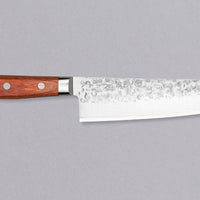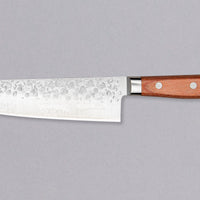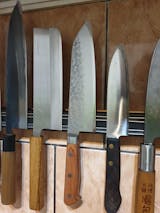

Takamura Santoku Tsuchime Chromax Brown 170mm (6.7")
🚩 This blade will develop patina with use, while improper maintenance may lead to rust formation.
|
✔︎ No import fees & duties - worldwide |
- Description
- Specifications
- Knife Care
- Shipping
Takamura Santoku Chromax Tsuchime Brown 170mm is a multi-purpose Japanese kitchen knife that won’t require you to break the bank. It’s the first knife that we offer made of Chromax steel, which is a new kitchen knife steel with some enviable attributes. It’s very hard (64-65 HRC), easy to sharpen and semi-stainless, which means it will resist corrosion better than traditional high-carbon Japanese knife steels. Together with a high-quality western (Yo) style pakka wood handle, this is a real performer made for anyone looking to get the maximum out of their knife.
BLADE SHAPE:
The Japanese word Santoku roughly translates to “knife of three virtues” and may refer to the wide variety of ingredients that the knife can handle: meat, fish and vegetables, or to the tasks it can perform: slicing, chopping and dicing - the emphasis being on the number 3 (San). Its distinguishing shape makes the santoku easy to identify: the cutting edge is fairly straight (giving santoku a limited rocking motion), while the spine of the blade curves towards the tip continuously at an approximately 60-degree angle, making it resemble a sheep's foot.
STEEL:
Chromax steel is a kitchen knife steel with some pretty unique characteristics under its belt. It’s much more corrosion resistant than high-carbon steels, but it’s still categorized as semi-stainless. That means that it’s not as prone to rusting, but can still form a patina over time and react with acidic vegetables and fruit. It also sharpens very nicely, and in that regard behaves much like a high-carbon steel. The steel can be hardened to an impressive hardness of 65 HRC. Chromax steel is composed of 1% Carbon, 5% Chromium, 0.9% Manganese, 1.2% Molybdenum and 0.5% Vanadium.
LAMINATION:
The core layer consisting of the harder Chromax steel was sandwiched between two layers of softer, more corrosion resistant steel. This technique is called san-mai and is used to protect the hard (but delicate) core from outside factors, such as rusting and physical impacts, which could lead to breakage.
GEOMETRY:
It has a double bevel (symmetrical) blade.
BLADE FINISH:
The blade’s look is defined by shallow hammer strike impressions, which leave the upper part of the blade with a textured, rustic look. The kanji (blacksmith’s signature) is hand-chiseled, adding to the authentic Japanese look.
HANDLE:
Classic Western (Yo) style handle, made from pakka wood with brushed steel rivets in a sunwashed brick color.
ABOUT THE BLACKSMITH:
Takamura Hamono is a smithy located in Echizen (Fukui Prefecture) owned by the Takamura family for over 60 years. It is now headed by the eldest son Terukazu Takamura, who took over from his father Toshiyuki (who took over from his father, the smithy’s founder Isamu Takamura-san). The knives Terukazu-san has been making since 1985 are known for their outstanding geometry, sophistication in design, and sharpness. Their quality was recognized in a consumer test report Smartson in Sweden, where they beat the competition. Takamura Hamono has gained notoriety since the knives became the #1 choice of world-renowned chefs such as Gordon Ramsay, René Redzepi, Mark Best, Hiromi Yamada, and the TV personality Martha Stewart (just to name a few!).
All of this makes Takamura knives very difficult to obtain and the wait time is very long due to a limited production capacity. Nevertheless, the craftsmanship and sophistication of their products make the wait well worthwhile.
Blade shape: Santoku
Steel type: Chromax
Blade construction: San-mai / tsuchime
Hardness (HRC scale): 65
Overall length: 295mm (11.6")
Blade length: 170mm (6.7")
Blade height: 46mm (1.8")
Spine thickness: 1.7mm (0.07")
Weight: 155g (5.5 oz)
Handle length: 120mm (4.7")
Handle type / wood: Western / Pakka
Kanji on the blade:
Blacksmith: Takamura Hamono
Location of the smithy: ECHIZEN - TAKEFU KNIFE VILLAGE / Fukui Prefecture / Japan
☝️ Japanese kitchen knives in our store are handmade from natural materials. Slight variations in color, texture, weight and other dimensions are possible. We try to give a good photographic representation of our products, however computer screen resolution and colors do vary, so products might not look exactly as they are seen on screen.

☝️ THIS KNIFE MAY DEVELOP PATINA
Knives made of carbon steels can, due to their low chromium (Cr) content, discolor and develop patina. The knife is the most sensitive when it is still new and a patina had not developed yet, but later, patina will protect the blade. These types of knives require a touch more care:
✔ Wipe it regularly with a clean and dry cloth (you can also do this during use).
✔ After use, rinse it with lukewarm water and wipe it dry.
✔ Coat it regularly with knife maintenance oil or plain refined sunflower oil.
✔ Store the knife by wrapping it in paper which will absorb moisture and protect the blade.
A patina is a thin layer that forms on the surface of oxidized steel and protects it from further oxidation. The patina should not be confused with rust. Patina protects the blade, while rust causes corrosion and deterioration of material, so it should be removed (see Rust erasers).
→ For in-depth information about patina, read our dedicated post on patina.
GENERAL KNIFE CARE TIPS:
Blade wear depends on the quality of steel, usage and maintenance of the blade. Japanese knives are made of high-quality steels. Follow these tips to keep your Japanese knife in top-notch shape:
✔ Use a wooden, plastic or rubber cutting board.
✔ After use, wash the knives and wipe them dry.
✔ For storage, use a knife holder or a protective knife sheath (saya).
✔ A good cutting technique is your best bet to prolong sharpness.
✔ Use sharpening stones to sharpen the knife.
❗️Don’t leave the knife in the sink. Wash it by hand.
❗️Don’t wash the knife in the dishwasher.
❗️Don’t use the knife on glass, ceramics, marble or steel surfaces.
❗️Don’t scrape the food off the cutting board with the edge of the blade. Use the spine of the knife instead.
❗️Knife is a tool intended for specific use - cutting food. It is not a can opener, screwdriver, trowel, wire cutter, hammer etc.
→ For more details, read our guide
on Maintenance of Kitchen Knives.
🤙 Contact us if you need some help. We reply within 1 business day.
SHIPPING RATES:
- €10 - flat worldwide rate with DHL Express (express delivery, 2-5 business days).
- FREE - all orders over €300 (DHL Express).
EXCEPTIONS:
See our Shipping page for more details.
DUTIES AND IMPORT TAXES:
We ship all orders DDP (duties & taxes paid). This means you will not be charged for any import fees and taxes (including VAT). All our prices are final. The price you see at checkout is the final price, no hidden costs.
DELIVERY TIME:
- Europe: 1-2 business days
- US & Canada: 2-4 business days
- Rest of the World: 3-5 business days
RETURNS:
Our return policy lasts 30 days. If more than 30 days have gone by since the day you received your order, unfortunately we can’t offer you a refund or exchange.
→ Read our SHIPPING & RETURNS policy for more info. We strive to solve any issues fast and with as little hassle for you. If you have some additional questions, please contact us.
Each knife comes with:
✔️ Instructions and knife care leaflet.
✔️ A preventive Band-Aid – the knives are very sharp! 😉
✔️ Original box from the blacksmith, which we wrap in an old Japanese newspaper sheet – so every knife is ready to be passed on as a gift as soon as it hits your doorstep!
✔️ We also offer a special gift wrapping option with the traditional Japanese washi paper.
Quiz
Still doubting which type of Japanese knife should best fit your needs?
We created a 5-steps quiz to help you find the perfect knife based on your cooking skills and the type of food you prepare.



